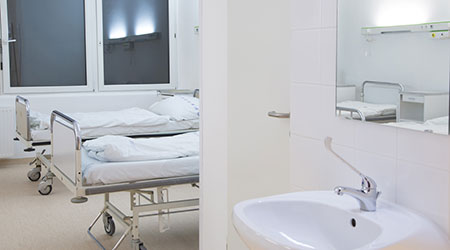It is widely acknowledged that contaminated surfaces, particularly those that are high-tough or high-use, pose an infection transmission risk in healthcare facilities. Additionally, studies over the past decade have demonstrated that traditional healthcare facility environmental cleaning and microbial reduction methods are inadequate, particularly in the face of rising numbers of antimicrobial resistant organisms.1-2
As a result, there has been a tremendous focus on optimizing cleaning protocols and deployment of newmicrobial reduction technologies, many of which have demonstrated impressive results in published studies. Even with these advancements, some significant challenges remain.
The vast majority of these efforts have centered around terminal cleaning of patient rooms. This is only part of a successful microbial reduction strategy, though, as portable equipment transferred between patient rooms and healthcare workers themselves, via contact with high-touch/high-use surfaces can serve as vectors for transmission.1
Furthermore, many of the effective automated microbial reduction systems can only be employed in an unoccupied room, presenting logistical challenges to healthcare facilities with high volumes and, thus, the need for rapid room turnover.3
A 2015 report published in the American Journal of Infection Control,4 however, described a novel application of an environmental microbial reduction technology that has been previously utilized in agriculture and biodefense outside of healthcare for reduction of microbial contamination. This technology utilizes dry hydrogen peroxide.
It offers an efficient adjunct solution to the aforementioned challenges by providing continuous microbial reduction in occupied spaces and potentially evoke a paradigm shift in healthcare environmental cleaning and microbial reduction efforts.
Modern microbial reduction strategies: Manual cleaning, antimicrobial surfaces, automated systems
Modern microbial reduction strategies can be categorized into three broad categories: manual cleaning, antimicrobial surfaces, and automated “no-touch” systems. There have been considerable advancements over the years in manual cleaning efforts, including among liquid antimicrobial and sporicidal agents (e.g. electrolyzed water or hypochlorous acid), methods for applying these agents (e.g. microfiber/ultra-microfiber cloths, electrostatic spraying), and monitoring systems (e.g. adenosine triphosphate/ATP assays) to evaluate for adequacy of microbial reduction.1,5
The benefit of manual cleaning is that a rapid effect can be achieved without capital equipment expenditures. The drawbacks, however, include the fact that it is labor intensive and the efficacy is dependent on compliance with protocol and thoroughness---two factors that have been demonstrated in studies to be widely variable and often suboptimal.6
Additionally, manual cleaning is obviously an intermittent solution to what is inherently a continuous problem and does not address airborne contamination.
Antimicrobial surfaces, in which equipment ranging from counter-tops to privacy curtains are impregnated with molecules such as copper or silver that possess antimicrobial properties, have become an increasingly popular environmental microbial reduction strategy as they provide a continuous effect with no increased labor requirements.
Their effect, however, is obviously limited to only the surfaces that are treated/impregnated and the costs associated with broad utilization can be significant. More importantly, it is unclear what the long-term antimicrobial potency and cost-effectiveness of these surfaces are.1
Automated systems, utilizing ultraviolet radiation or vaporized agents, arguably represent the biggest area of growth in environmental microbial reduction efforts. However, these systems ---ultraviolet radiation and vaporized hydrogen peroxide---pose a risk to humans and thus can only be utilized in unoccupied spaces, representing a logistical challenge to high-turnover facilities.1,3
Like manual cleaning, they are an intermittent microbial reduction solution, and like antimicrobial surfaces, they require a significant capital expenditure.
Tackling microbial reduction challenges with a novel application of an existing technology: Dry hydrogen peroxide
Dry hydrogen peroxide or DHP (Synexis Biodefense Systems, Overland Park, Kan.), a non-aqueous gas, has been used for environmental disinfection in fields such as agriculture, biodefense/government, and sports for some time and is increasingly gaining attention in the healthcare community because of its ability to meet some of the aforementioned microbial reduction challenges.7-8
The biocidal activity of hydrogen peroxide in any form — liquid, vapor, dry gas — is rooted in the fact that microbes require water and have electrostatically charged points on their cells designed to attract water molecules from the environment .9
Hydrogen peroxide molecules are very similar to water molecules and thus are also attracted to these charged points; however, unlike water molecules, hydrogen peroxide attacks microbes and disrupts their cell membrane. Because hydrogen peroxide will compete with water molecules for access to these points on a microbe’s cell wall, higher concentrations of hydrogen peroxide are needed to effectively disinfect when in the presence of water.9
This explains why commercially available hydrogen peroxide vapor systems utilizing a vaporized mixture of water and hydrogen peroxide cannot be used in occupied spaces as their hydrogen peroxide concentrations exceed acceptable safety limits for human exposure established by the Occupational Safety and Health Administration (OSHA).1,10
By contrast, Synexis DHP gas can be catalytically produced from gases already in the air---ambient oxygen and humidity (water molecules in gas form)---and achieve microbial reduction at concentrations well below OSHA’s safety limits, allowing it to be safely used in occupied rooms.11-12
Furthermore, unlike aqueous forms of hydrogen peroxide, including vapors, that are acidic because of the chemical properties associated with mixing hydrogen peroxide and water, dry hydrogen peroxide gas does not damage surfaces in a room. Therefore, the integrity of surfaces ranging from those of electronic monitoring devices to soft privacy curtain are not compromised. 12-13
The systems that facilitate this catalytic production of Synexis DHP can be installed in a facility’s HVAC system or used as stand-alone units and provide continuous disinfection without the need for a room to be vacated.
As a gas, the Synexis DHP can permeate throughout a space, reaching and reducing microbial bioburden in remote, recessed areas within a room. Thus, the challenges of compliance, comprehensive microbial reduction, and disruption to patient throughput are eliminated. And, while there will always be a role for manual cleaning, those areas that receive intermittent cleaning will benefit by the continuous microbial reduction process afforded by Synexis DHP.
Additionally, because continuous microbial reduction provided by DHP reduces the steady state of environmental contamination, standard intermittent adjunctive cleaning interventions address a much lower bioburden and is therefore more effective.
DHP was deployed in a community hospital in Pennsylvania
The results of the hospital’s experience with Synexis DHP garnered the distinguished William A. Rutala award for best abstract on the subject of disinfection, sterilization, or antisepsis in 2015.4
They incorporated Synexis DHP technology into the existing HVAC system of their 34-bed cardiovascular telemetry unit and evaluated its impact on microbial contamination within the unit. To create a baseline, researchers took culture samples from hospital rooms and common work areas within the unit before and after standard hospital cleaning.
Upon implementation of Synexis DHP technology, they collected samples from the same rooms and work areas daily for one week. They noted significant reductions in microbial contamination after instituting Synexis DHP technology.
Among the most notable findings were the complete eradication of Staphylococcus aureus, Candida parapsilosis, Pseudomonas putida, Flavobacterium meningosepticum, Pseudomonas picketti, and Citrobacter spp.4Additionally, microbial bioburden reductions were noted in : Alcaligenes Xylosoxidans (68%), Pseudomonas aeruginosa (95%), and Enterobacter spp (50%) following completion of standard terminal cleaning to seven days post- DHP implementation.
Implications for healthcare facilities
Reducing environmental contamination in an effort to mitigate infection transmission has long been a top priority for healthcare facilities. It is a challenge that is heightened by the extended survival times many pathogens, including multidrug-resistant organisms, have on hard surfaces.14
Research have shown that reductions in environmental bioburden leads to better patient outcomes, but also may bolster a facility’s bottom line. In this era of high reliability healthcare and performance-based federal reimbursement, it is imperative that healthcare facilities continually evaluate their environmental microbial reduction strategies to identify strengths and weaknesses. Facility managers, infection preventionists, and environmental service managers should be asking the questions, “Is the system effective?
Does it provide continuous microbial reduction thereby mitigating the inevitable risk of recontamination? Does it impact our patient throughput? Is it safe for healthcare workers and patients alike? Is it comprehensive? Is it cost-effective?”
The adage, “No question is a dumb question” is particularly relevant with microbial reduction technologies as it can be confusing trying to distinguish between “friendly oxidizers”, bipolar ionization, plasma fields, and systems producing ozones. Instead, ask the basic question, “Is the system truly emitting hydrogen peroxide gas?”
Michelle Vignari, RN, BSN, CIC, Infection Preventionist, University of Rochester Medical Center, Highland Hospital, Rochester, N.Y.; Charles E. Edmiston, PhD, CIC, Emeritus Professor of Surgery, Department of Surgery, Medical College of Wisconsin, Milwaukee, Wis.
1) Boyce JM. Modern technologies for improving cleaning and disinfection of environmental surfaces in hospitals. Antimicrob Resist Infect Control 2016; 5:10.
2) Donskey CJ. Does improving surface cleaning and disinfection reduce health care-associated infections? Am J Infect Control. 2013; 41:S12–9.
3) Spencer M, Vignari M, Boyce E. A model for choosing an automated ultraviolet-C disinfection system and building a case for the C-suite: two case reports. Am J Infect Control 2017; 45(3): 288-292.
4) Herman CK, Hess J, Cerra C. Dilute hydrogen peroxide technology for reduction of microbial colonization in the hospital setting. Am J Infect Control 2015; S25-S26.
5)Robertson JT. Electrostatic technology for surface disinfection in healthcare facilities. Available from: https://infectioncontrol.tips/2016/10/14/electrostatic-in-healthcare/. Accessed 23 January 2018.
6) Carling PC, Bartley JM. Evaluating hygienic cleaning in health care settings: what you do not know can harm your patients. Am J Infect Control. 2010; 38:S41–50.
7) Topkin M. Bug off! Rays fight back against Red Sox germs. Tampa Bay Times. 2018. Available from : http://www.tampabay.com/sports/baseball/rays/bug-off-rays-fight-back-against-red-sox-germs/2320303. Accessed 22 January 2018.
8) City of Guelph. City tests air purification and disinfection system at two facilities. 2017. Available from: http://guelph.ca/2017/02/air-purification-system/. Accessed 22 January 2018.
9) Centers for Disease Control and Prevention. Guidelines for disinfection and sterilization in healthcare facilities, 2008. Available from: https://www.cdc.gov/infectioncontrol/pdf/guidelines/disinfection-guidelines.pdf. Accessed 31 January 2018.
10) Occupational Safety and Health Administration. Chemical sampling information: hydrogen peroxide. Available from: https://www.osha.gov/dts/chemicalsampling/data/CH_246600.html. Accessed 19 January 2018.
11) Steinagel, S. “Disinfection Efficacy Evaluation of Hydrogen Peroxide Generating Unit.” ATS Labs Project Number A06534. 7 Aug. 2008: 11.
12) Synexis Biodefense Systems. Material safety data sheet for dry hydrogen peroxide 2017. Available from: https://synexisbiodefense.egnyte.com/dl/Q28odUGrAn/ Accessed 29 May 2019.
13) McDonnell, G. The Use of Hydrogen Peroxide for Disinfection and Sterilization Applications. In: Patai's Chemistry of Functional Groups; John Wiley and Sons, Ltd.: Hoboken, NJ, USA, 2009.
14) Chemaly RF, Simmons S, Dale C, et al. The role of the healthcare environment in the spread of multidrug-resistant organisms: update on current best practice for containment. Ther Adv Infect Dis 2014; 2(3-4):79-90.

 Technology Trends for Healthcare Real Estate in 2025
Technology Trends for Healthcare Real Estate in 2025 Advocate Healthcare Invests $1 Billion Into Chicago's South Side
Advocate Healthcare Invests $1 Billion Into Chicago's South Side Children's Medical Center Plano Opens New Patient Tower
Children's Medical Center Plano Opens New Patient Tower Layered Security on the Rise in Facilities
Layered Security on the Rise in Facilities OhioHealth Plans New Comprehensive Outpatient Cancer Center
OhioHealth Plans New Comprehensive Outpatient Cancer Center